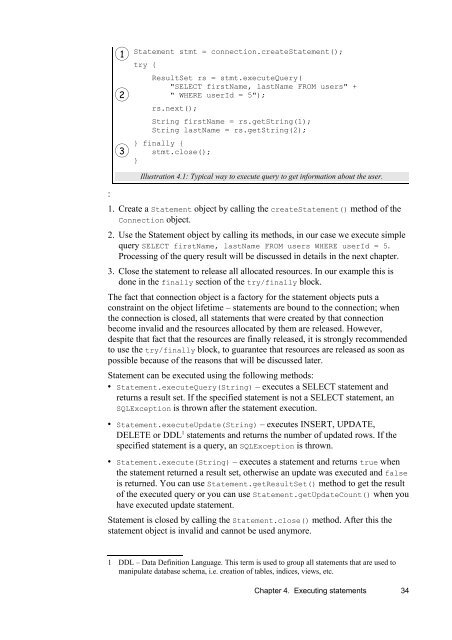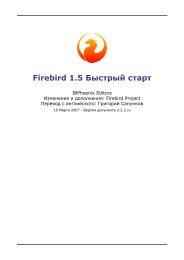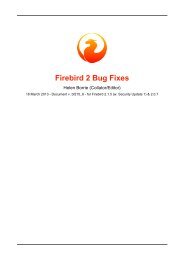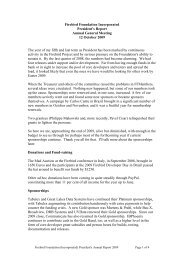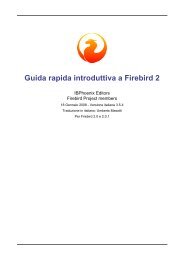Jaybird 2.1 JDBC driver Java Programmer's Manual - Firebird
Jaybird 2.1 JDBC driver Java Programmer's Manual - Firebird
Jaybird 2.1 JDBC driver Java Programmer's Manual - Firebird
Create successful ePaper yourself
Turn your PDF publications into a flip-book with our unique Google optimized e-Paper software.
:<br />
1<br />
2<br />
3<br />
Statement stmt = connection.createStatement();<br />
try {<br />
ResultSet rs = stmt.executeQuery(<br />
"SELECT firstName, lastName FROM users" +<br />
" WHERE userId = 5");<br />
rs.next();<br />
String firstName = rs.getString(1);<br />
String lastName = rs.getString(2);<br />
} finally {<br />
stmt.close();<br />
}<br />
Illustration 4.1: Typical way to execute query to get information about the user.<br />
1. Create a Statement object by calling the createStatement() method of the<br />
Connection object.<br />
2. Use the Statement object by calling its methods, in our case we execute simple<br />
query SELECT firstName, lastName FROM users WHERE userId = 5.<br />
Processing of the query result will be discussed in details in the next chapter.<br />
3. Close the statement to release all allocated resources. In our example this is<br />
done in the finally section of the try/finally block.<br />
The fact that connection object is a factory for the statement objects puts a<br />
constraint on the object lifetime – statements are bound to the connection; when<br />
the connection is closed, all statements that were created by that connection<br />
become invalid and the resources allocated by them are released. However,<br />
despite that fact that the resources are finally released, it is strongly recommended<br />
to use the try/finally block, to guarantee that resources are released as soon as<br />
possible because of the reasons that will be discussed later.<br />
Statement can be executed using the following methods:<br />
• Statement.executeQuery(String) – executes a SELECT statement and<br />
returns a result set. If the specified statement is not a SELECT statement, an<br />
SQLException is thrown after the statement execution.<br />
• Statement.executeUpdate(String) – executes INSERT, UPDATE,<br />
DELETE or DDL 1 statements and returns the number of updated rows. If the<br />
specified statement is a query, an SQLException is thrown.<br />
• Statement.execute(String) – executes a statement and returns true when<br />
the statement returned a result set, otherwise an update was executed and false<br />
is returned. You can use Statement.getResultSet() method to get the result<br />
of the executed query or you can use Statement.getUpdateCount() when you<br />
have executed update statement.<br />
Statement is closed by calling the Statement.close() method. After this the<br />
statement object is invalid and cannot be used anymore.<br />
1 DDL – Data Definition Language. This term is used to group all statements that are used to<br />
manipulate database schema, i.e. creation of tables, indices, views, etc.<br />
Chapter 4. Executing statements 34


